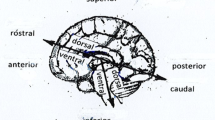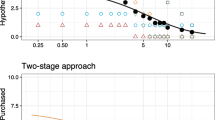Abstract
Canonical models of rational choice fail to account for many forms of motivated adaptive behaviors, specifically in domains such as food selections. To describe behavior in such emotion- and reward-laden scenarios, researchers have proposed dual-process models that posit competition between a slower, analytic faculty and a fast, impulsive, emotional faculty. In this paper, we examine the assumptions and limitations of these approaches to modeling motivated choice. We argue that models of this form, though intuitively attractive, are biologically implausible. We describe an approach to motivated choice based on sequential sampling process models that can form a solid theoretical bridge between what is known about brain function and environmental influences upon choice. We further suggest that the complex and dynamic relationships between biology, behavior, and environment affecting choice at the individual level must inform aggregate models of consumer choice. Models using agent-based complex systems may further provide a principled way to relate individual and aggregate consumer choices to the aggregate choices made by businesses and social institutions. We coin the term “brain-to-society systems” choice model for this broad integrative approach.

Similar content being viewed by others
References
Ashby, F. G., & Townsend, J. T. (1986). Varieties of perceptual independence. Psychological Review, 93, 154–179. doi:10.1037/0033-295X.93.2.154.
Axtell, R. L., et al. (2002). Population growth and collapse in a multiagent model of the Kayenta Anasazi in Long House Valley. Proceedings of the National Academy of Sciences of the United States of America, 99(3), 7275–7279. doi:10.1073/pnas.092080799.
Bechara, A., & Damasio, A. (2004). The somatic marker hypothesis: A neural theory for economic decisions. Games and Economic Behavior, 1, 1–37 (Special issue on Neuroscience and Economics).
Bernheim, B. D., & Rangel, A. (2004). Addiction and cue-triggered decision processes. The American Economic Review, 94(5), 1558–159. doi:10.1257/0002828043052222.
Berthoud, H.-R. (2002). Multiple neural systems controlling food intake and body weight. Neuroscience and Biobehavioral Reviews, 26, 393–428. doi:10.1016/S0149-7634(02)00014-3.
Böckenholt, U. (2007). Thurstonian-based analysis: past, present and future utilities. Psychometrika, 10, 1336–1350.
Broberger, C. (2005). Brain regulation of food intake and appetite: Molecules and networks. Journal of Internal Medicine, 258, 301–327. doi:10.1111/j.1365-2796.2005.01553.x.
Busemeyer, J. R., & Diederich, A. (2002). Survey of decision field theory. Mathematical Social Sciences, 43, 345–370. doi:10.1016/S0165-4896(02)00016-1.
Busemeyer, J. R., & Townsend, J. T. (1993). Decision field theory: A dynamic-cognitive approach to decision making in an uncertain environment. Psychological Review, 100, 432–459. doi:10.1037/0033-295X.100.3.432.
Cacioppo, J. T., Bernston, G. G., Sheridan, J. F., & McClintock, M. K. (2000). Multilevel integrative analysis of human behavior: Social neuroscience and the complementing nature of social and biological approaches. Psychological Bulletin, 126(6), 829–843. doi:10.1037/0033-2909.126.6.829.
Chen, S., & Chaiken, S. (1999). The heuristic–systematic model in its broader context. In S. Chaiken, & Y. Trope (Eds.), Dual-process theories in social psychology (pp. 73–96). New York: Guildford.
Chintagunta, P., Erdem, T., Rossi, P. E., & Wedel, M. (2006). Structural modeling in marketing: Review and assessment. Marketing Science, 25, 604–616. doi:10.1287/mksc.1050.0161.
Desmeules, R., Bechara, A., & Dubé, L. (2008). Subjective valuation and asymmetrical motivational systems: Implications of scope insensitivity for decision making. Journal of Behavioral Decision Making, 21, 211–224.
DeSarbo, W. S., Di Benedetto, C. A., Jedidi, K., & Song, M. (2006). Identifying sources of heterogeneity for empirically deriving strategic types: A constrained finite-mixture structural equation methodology. Management Science, 52, 909–924. doi:10.1287/mnsc.1060.0529.
Diederich, A. (1997). Dynamic stochastic models for decision making under time constraints. Journal of Mathematical Psychology, 41, 260–274. doi:10.1006/jmps.1997.1167.
Dubé, L., Le Bel, J., & Lu, J. (2005). Affect asymmetry and comfort food consumption. Physiology & Behavior, 86(4), 559–567. doi:10.1016/j.physbeh.2005.08.023.
Epstein, J. (2002). Modeling civil violence: An agent-based computational approach. Proceedings of the National Academy of Sciences of the United States of America, 99, 7243–7250. doi:10.1073/pnas.092080199.
Erden, T., Srinivasan, W., Amaldoss, P., Bajari, H., Che, T., et al. (2005). Theory driven choice models. Marketing Letters, 16, 225–237. doi:10.1007/s11002-005-5887-z.
Förster, J. (2002). How body feedback influences consumers’ evaluation of products. Journal of Consumer Psychology, 14, 416–426. doi:10.1207/s15327663jcp1404_10.
Fudenberg, D., & Levine, D. K. (1999). Conditional universal consistency. Games and Economic Behavior, 29, 104–130. doi:10.1006/game.1998.0705.
Faruk, G., & Pesendorfer, W. (2001). Temptation and Self-Control. Econometrica, 69, 1403–1435.
Hammond, R. A., & Epstein, J. M.(2007). “Exploring price independent mechanisms in the obesity epidemic”. Center on Social and Economic Dynamics Working Paper, p. 48.
Herman, C. P., Roth, D. A., & Polivy, J. (2003). Added effects of the presence of others on food intake: A normative interpretation. Psychological Bulletin, 129(6), 873–886. doi:10.1037/0033-2909.129.6.873.
Huettel, S. A., Song, A. W., & McCarthy, G. (2005). Decisions under uncertainty: Probabilistic context influences activity of prefrontal and parietal cortices. The Journal of Neuroscience, 25, 3304–3311. doi:10.1523/JNEUROSCI.5070-04.2005.
Huk, A. C., & Shadlen, M. N. (2005). Neural activity in macaque parietal cortex reflects temporal integration of visual motion signals during perceptual decision making. The Journal of Neuroscience, 25(45), 10420–10436. doi:10.1523/JNEUROSCI.4684-04.2005.
Johnson, J. G., & Busemeyer, J. R. (2005). A dynamic computational model of preference reversal phenomena. Psychological Review, 112, 841–861. doi:10.1037/0033-295X.112.4.841.
Kalivas, P. W., & Volkow, N. D. (2005). The neural basis of addiction: A pathology of motivation and choice. American Journal of Psychiatry, 162, 8, 1403.
Killgore, W. D. S., Young, A. D., Femia, L. A., Bogorodzki, P., Rogowska, J., & Yurgelun-Todd, D. A. (2003). Cortical and limbic activation during viewing of high- versus low-calorie foods. NeuroImage, 19(4), 1381–1394. doi:10.1016/S1053-8119(03)00191-5.
Klucharev, V., Hytonen, K., Rijpkema, M., Smidts, A., and Fernandexz, G. (2008). An error of being different? Brain mechanisms of social norms. Working Paper, F. C. Donders Center for Cognitive Neuroimaging, Radbout University Nijmegen.
Knutson, B., Rick, S., Wimmer, G. E., Prelec, D., & Lowenstein, G. (2007). Neural predictors of purchases. Neuron, 53, 147–156. doi:10.1016/j.neuron.2006.11.010.
Laibson, D. (2001). A cue-theory of consumption. The Quarterly Journal of Economics, 116, 81–119. doi:10.1162/003355301556356.
Loewenstein, G., & O’Donoghue, T. (2004). Animal spirit: Affective and deliberative processes in economic behavior. Worker Paper, Carnegie Mellon University.
McClure, S. M., Li, J., Tomlin, D., Cypert, K. S., Montague, L. M., & Montague, P. R. (2004). Neural correlates of behavioral preference for culturally familiar drinks. Neuron, 44(2), 379–387. doi:10.1016/j.neuron.2004.09.019.
Mischel, W., Ebbesen, E. B., & Zeiss, A. R. (1972). Cognitive and attentional mechanisms in delay of gratification. Journal of Personality and Social Psychology Bulletin, 21, 204–218.
O’Doherty, J., et al. (2001). Abstract reward and punishment representations in the human orbitofrontal cortex. Nature Neuroscience, 4, 95–102. doi:10.1038/82959.
O’Donoghue, T., & Rabin, M. (1999). Doing it now or later. The American Economic Review, 89, 103–124.
Otter, T., Rieskamp, J., Brazell, J. D., Hutchinson, W., Ruan, S., et al. (2008). Psychological processes underlying violations of Luce’s choice axiom. Marketing Letters (this issue).
Padoa-Schioppa, C., & Assad, J. A. (2006). Neurons in the orbitofrontal cortex encode economic value. Nature, 441, 223–226. doi:10.1038/nature04676.
Petty, R. E., & Cacciopo, J. T. (1986). The elaboration likelihood model of persuasion. In L. berkowitz (Ed.), Advances in experimental social psychology, vol 19 (pp. 123–205). New York: Academic.
Plassmann, H., O’Doherty, J., Shiv, B., & Rangel, A. (2008). Marketing actions can modulate neural representations of experienced processes. Proceedings of the National Academy of Sciences of the United States of America, 105(3), 1050–1054. doi:10.1073/pnas.0706929105.
Platt, M. L., & Glimcher, P. W. (1999). Neural correlates of decision variables in parietal cortex. Nature, 400, 233–238. doi:10.1038/22268.
Read, D., & van Leeuwen, B. (1998). Predicting hunger: The effect of appetite and delay on choice. Organizational Behavior and Human Decision Processes, 76, 189–205. doi:10.1006/obhd.1998.2803.
Rorie, A. E., & Newsome, W. T. (2005). A general mechanism for decision making in the human brain. Trends in Cognitive Sciences, 9(2), 41–43. doi:10.1016/j.tics.2004.12.007.
Schultz, W. (1998). Predictive reward signal of dopamine neurons. Journal of Neurophysiology, 80, 1–27.
Small, D. M., Gotman, M. J., & Dagher, A. (2003). Feeding induced dopamine release in dorsal striatum correlates with meal pleasantness rating in healthy human volunteer. NeuroImage, 19, 1709–1715. doi:10.1016/S1053-8119(03)00253-2.
Sen, A. (1993). Internal consistency of choice. Econometrica, 61(3), 495–521. doi:10.2307/2951715.
Sengupta, J., & Zhou, R. (2007). Understanding impulsive eaters’ choice behaviors: The motivational influences of regulatory focus. JMR, Journal of Marketing Research, 44, 297–308. doi:10.1509/jmkr.44.2.297.
Shiv, B., Bechara, A., Levin, I., Alba, J. W., Bettman, J. R., et al. (2005). Decision neuroscience. Marketing Letters, 16, 375–386. doi:10.1007/s11002-005-5899-8.
Shiv, B., & Fedorikhin, A. (1999). Heart and mind in conflict: The interplay of affect and cognition in consumer decision making. The Journal of Consumer Research, 26(December), 278–292. doi:10.1086/209563.
Spitzer, M., Fischbacher, U., Herrberger, B., Gron, G., & Fehr, E. (2007). The neural signature of social norm compliance. Neuron, 48, 175–187.
Strack, F., Werth, L., & Deutsch, R. (2006). Reflective and impulsive determinants of consumer behaviour. Journal of Consumer Psychology, 16(3), 205–216. doi:10.1207/s15327663jcp1603_2.
Sugrue, L. P., Corrado, G. S., & Newsome, W. T. (2005). Choosing the greater of two goods: Neural currencies for valuation and decision making. Nature Neuroscience, 6, 363–375.
Volkow, N. D., & O’ Brien, C. P. (2007). Issues for DSM-V: Should obesity be included as a brain disorder? The American Journal of Psychiatry, 164(5), 708–710.
Wise, R. A. (2004). Dopamine, learning and motivation. Nature Reviews. Neuroscience, 5, 483–494. doi:10.1038/nrn1406.
Wansink, B. (2006). Mindless eating: Why we eat more than we think. New York: Bantam.
Author information
Authors and Affiliations
Corresponding author
Additional information
Authors include participants to the Brain-to-Society Systems of choice session at the Choice Symposium and members of the research team.
Contents of this publication do not necessarily reflect the views or policies of the National Institutes of Health.
An erratum to this article can be found at http://dx.doi.org/10.1007/s11002-008-9067-9
Rights and permissions
About this article
Cite this article
Dubé, L., Bechara, A., Böckenholt, U. et al. Towards a brain-to-society systems model of individual choice. Mark Lett 19, 323–336 (2008). https://doi.org/10.1007/s11002-008-9057-y
Published:
Issue Date:
DOI: https://doi.org/10.1007/s11002-008-9057-y




